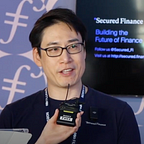DeFi blog series
When Traditional Finance Meets DeFi
4 key factors to move further toward DeFi 2.0
Introduction
In this article, we introduce how traditional finance looks at the current DeFi space and discuss what’s going to happen next. The author spent 17 years in finance including derivatives structuring and trading, and is at the same time a software engineer focusing on distributed ledger technology. This is the first article of the DeFi blog series presented by Secured Finance.
What is DeFi?
DeFi is the short form of Decentralized Finance; however, there seems to be an effective difference between those two. There are no standard definitions yet, but let’s see how those are different.
- DeFi is a genre of DApps that provides specific financial services. We saw many projects on the Ethereum blockchain this year. Each project has its own protocol which in general is not shared among other projects.
- Decentralized Finance is a domain of finance that focuses on applications of technologies that may reduce or eliminate the need for one or more intermediaries or centralized processes in the provision of financial services. (FSB: Decentralized Financial Technologies)
How traditional finance see the current DeFi trends
Let’s zero in on DeFi as part of the financial system and see if there is any problem with it. When traditional finance people hear the word ‘finance’, they make an implicit assumption as follows:
- Financial products can be in any format such as a bond, note, equity, currency, commodity, fund, deposit, loan, real-estate property, intellectual property, rights to buy or sell in the future, etc.
- Anything can be handled as long as we can calculate a value, which can be represented in any way such as digital or non-digital, tangible or intangible.
- Assets can be seamlessly moved and converted from one to another no matter how they are kept (whether it be on-chain or ledger paper). The transfer can be done via a centralized middleman or decentralized peer-to-peer manner.
So finance is, by nature, interoperable, cross-jurisdictional, and either centralized or decentralized economic activity. Thus, traditional finance people innately are familiar with the concept of DeFi and Decentralized Finance.
Recently, my old friend who works for Goldman Sachs for 12 years said:
I don’t understand why people discuss centralized vs decentralized. We just do businesses. — Goldman Sachs Director
For him, decentralized architecture is too natural to warrant discussion. In fact, traditional finance has been decentralized for 40 years. The first example of this was the cross-currency swap between IBM and the World Bank in 1981. We didn’t use the word ‘decentralized’, but peer-to-peer transactions with no exchanges & no intermediaries are already widely known as in over-the-counter (OTC) derivatives.
OTC derivatives market is gigantic. According to BIS statistics, a total notional amount is over 600 trillion dollars, which is about 7 times larger than the world’s GDP. With this size in mind, DeFi seems to be still in a very early stage and has a huge potential for growth.
The success of the OTC business is largely attributed to the use of a standardized agreement called the ISDA Master Agreement. It removed a lot of negotiation and legal costs related to peer-to-peer transactions and became an invaluable security measure for traders dealing in OTC derivatives.
Coming back to the assumptions by the ‘finance’ term entails, we can point out the following limitations in the current DeFi ecosystem:
- Tradable assets are limited to crypto-assets and in many cases, they are only ERC-20 tokens on Ethereum.
- Protocols are not standardized, therefore the siloed user base puts limitations on scalability.
- Most transactions are spot exchange or short-term.
- Most projects are led by software engineers and do not fully appreciate financial regulations.
Rise of DeFi 2.0
Although the current DeFi architecture has its limitations, it has played an important role, and we call this movement DeFi 1.0.
- A smart contract can work as a financial transaction platform.
- Crypto-assets are treated as a new asset class that generate interest rates.
- Spot and short-term liquidity can be managed by smart contracts.
Now let’s envision what’d be possible in the next version of DeFi and how Secured Finance can lead this field. In DeFi 2.0 we solve the limitations as follows:
- Handle native coins (ETH, BTC, FIL, USDC, etc..) as-is. We are developing a cross-chain interoperable oracle network to achieve 1st layer finance.
- Develop a standardized protocol compatible with the ISDA Master Agreement. We provide a zero-learning cost platform by using the same terminology and operations to invite traditional financial institutions.
- We develop yield curves and provide more liquidity and hedging products. This unlocks full-scale complex financial transactions.
- Financial regulators will not let DeFi grow without regulations. We will talk closely and embed regulatory perspective in our source code for compliance.
Conclusion
In this article, we reviewed the current DeFi trends from the perspective of traditional finance. 40 years of OTC derivatives gave us insights into how to solve limitations to move DeFi forward.
Finally, we are collecting early test pilot users through this P2P Financial Transaction Survey(1min). Please take a moment to complete it and we will send you the results and will keep you in a list for the Secured Finance token airdrop.
Next articles
The key driving force of DeFi 2.0
How to build yield curve and why it’s important
Filecoin: opportunities for traditional investors
Decentralized Financial Regulations
Please follow our Twitter account or join our Discord channel or Telegram. We welcome requests for articles and are happy to answer any questions.
Thank you very much!
